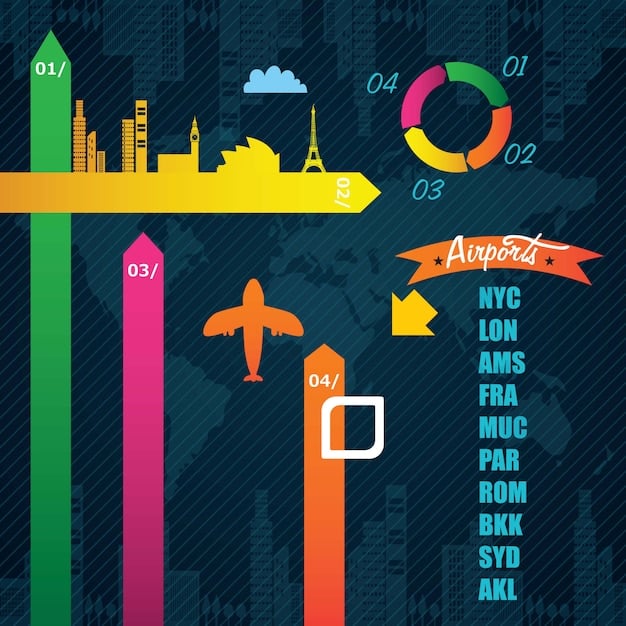Decoding Consumer Spending: Trends & Market Demand in the US

Consumer spending habits are undergoing a significant transformation in the US, influenced by factors like inflation, technological advancements, and evolving consumer preferences, directly impacting market demand across various sectors.
Understanding the consumer spending habits in the US is crucial for businesses aiming to thrive in today’s dynamic market. Shifts in preferences, economic factors, and technological advancements are reshaping how Americans spend their money, influencing market demand across various sectors.
The Evolving Landscape of US Consumer Spending
Consumer spending is a cornerstone of the US economy. However, it’s not static; it’s continuously evolving. Understanding these changes is essential for businesses to adapt and succeed.
Key Drivers of Change
Several factors are driving the evolution of consumer spending habits. Economic conditions, such as inflation and interest rates, play a significant role. Technological advancements, especially the rise of e-commerce, are also transforming how people shop. Finally, changing demographics and consumer preferences are influencing what people buy and how they buy it.
Impact on Market Demand
These shifts in consumer spending habits directly impact market demand. For example, increased online shopping has fueled demand for logistics and warehousing services. Growing concerns about sustainability are driving demand for eco-friendly products. Businesses that can anticipate and respond to these changes are more likely to succeed.

Here are some key trends that are shaping consumer spending:
- E-commerce Growth: Online shopping continues to grow, but brick-and-mortar stores are adapting with omnichannel strategies.
- Sustainability Concerns: Consumers are increasingly seeking eco-friendly and ethically sourced products.
- Experiences over Possessions: Many consumers, especially younger generations, prioritize experiences like travel and entertainment over material goods.
- Personalization: Consumers expect personalized products and services tailored to their individual needs and preferences.
In conclusion, the landscape of US consumer spending is dynamic and influenced by economic conditions, technological advancements, and evolving consumer preferences. Businesses must stay informed and adapt to these changes to meet market demand effectively.
Impact of Inflation on Consumer Behavior
Inflation has emerged as a major factor influencing consumer behavior. As prices rise, consumers are forced to make difficult choices about where to spend their money.
Inflation erodes purchasing power, meaning that consumers can buy less with the same amount of money. This leads to changes in spending habits, such as reduced discretionary spending and increased focus on value.
Strategies Consumers Adopt
To cope with inflation, consumers are adopting various strategies. Some are trading down to cheaper brands or private-label products. Others are cutting back on non-essential spending, such as dining out and entertainment. Loyalty programs are becoming more important as people seek discounts and rewards to stretch their budgets.
Retailers’ Response to Inflation
Retailers are responding to inflationary pressures in different ways. Some are absorbing some of the cost increases to maintain sales volume. Others are passing on the price increases to consumers but offering targeted promotions to mitigate the impact. Supply chain management is also becoming more critical to control costs and ensure product availability.

The followings are some trends in consumer behavior shaped by inflation:
- Trading Down: Consumers are opting for cheaper alternatives.
- Cutting Back: Reduction in non-essential spending.
- Seeking Value: Prioritizing discounts and loyalty rewards.
In summary, inflation significantly impacts consumer behavior, leading to strategies such as trading down and cutting back on non-essential spending. Retailers are adapting by absorbing some costs and offering targeted promotions to mitigate the impact of inflation on consumers.
The Rise of E-commerce and Its Impact on Retail
E-commerce has fundamentally altered the retail landscape, offering consumers unprecedented convenience and choice. This shift has profound implications for traditional brick-and-mortar stores.
E-commerce has grown exponentially over the past decade, fueled by increasing internet access and mobile device usage. Consumers can now shop from anywhere, at any time, and compare prices across multiple retailers with ease.
Omnichannel Strategies
Brick-and-mortar retailers are responding by adopting omnichannel strategies. This involves integrating online and offline channels to provide a seamless shopping experience. Examples include offering in-store pickup for online orders, providing mobile apps for in-store navigation, and personalizing the shopping experience based on online and offline data.
The Future of Retail
The future of retail is likely to be a hybrid model, with a mix of online and offline experiences. Retailers that can create a compelling and convenient shopping experience across all channels will be best positioned to succeed. This requires investing in technology, training employees, and adapting store layouts to meet the needs of today’s consumers.
Here are some examples of E-commerce’s impact on retail:
- Convenience: Shopping from anywhere at any time.
- Choice: Access to a vast array of products and retailers.
- Comparison: Easy price comparisons across multiple vendors.
In conclusion, the rise of e-commerce has significantly impacted the retail landscape, pushing brick-and-mortar stores to adopt omnichannel strategies. The future of retail is expected to be a hybrid model offering seamless shopping experiences both online and offline.
Sustainability and Ethical Consumption
Concerns about sustainability and ethical business practices are increasingly influencing consumer spending habits. Consumers are more aware of the environmental and social impact of their purchases and are seeking out companies that align with their values.
Demand for Eco-Friendly Products
There is growing demand for eco-friendly products made from sustainable materials and produced with minimal environmental impact. This includes products made from recycled materials, organic food, and energy-efficient appliances.
Ethical Sourcing and Fair Trade
Consumers are also concerned about ethical sourcing and fair trade practices. They want to know that the products they buy are made by workers who are treated fairly and that supply chains are transparent and responsible.
The main trends in sustainable and ethical consumption includes:
- Eco-Friendly Products: Growing demand for sustainable materials.
- Ethical Sourcing: Transparency and responsibility in supply chains.
- Social Impact: Alignment of purchases with personal values.
The shift towards sustainable and ethical consumption reflects a growing awareness of the environmental and social impact of purchases. Consumers are seeking companies that align with their values, driving demand for eco-friendly products and ethical sourcing practices. Businesses integrating these values are more likely to attract and retain customers.
The Influence of Social Media on Purchasing Decisions
Social media has become a powerful force in shaping consumer behavior. Platforms like Instagram, Facebook, and TikTok influence purchasing decisions through targeted advertising, influencer marketing, and peer reviews.
Targeted Advertising
Social media platforms collect vast amounts of data about their users, allowing advertisers to target specific demographics with personalized ads. This can be highly effective in driving sales, especially for products that are visually appealing or align with users’ interests.
The impact of Influencer Marketing
Influencer marketing has become a popular strategy for brands looking to reach new audiences. Influencers are individuals with a large following who promote products and services to their followers. This can be an effective way to build brand awareness and drive sales.
Here are some trends influenced based on Social Media:
- Targeted Advertising: Ads based on user data.
- Influencer Marketing: Promotion by individuals with large followings.
- Peer Reviews: Impact of user opinions on purchasing decisions.
Social media significantly influences purchasing decisions through targeted advertising, influencer marketing, and peer reviews. Brands leveraging these platforms can effectively reach consumers and drive sales by understanding the power of social influence.
Generational Differences in Spending Habits
Different generations have distinct spending habits, shaped by their unique experiences, values, and economic circumstances. Understanding these differences is crucial for businesses targeting specific age groups.
Baby Boomers
Baby Boomers (born 1946-1964) are generally affluent and value quality and customer service. They tend to spend on travel, healthcare, and home improvement. They are also more likely to be loyal to established brands.
Millennials
Millennials (born 1981-1996) are tech-savvy and prioritize experiences over possessions. They are more likely to shop online and are influenced by social media. They also value sustainability and ethical business practices.
Generation Z
Generation Z (born 1997-2012) is the most digitally native generation. They are highly price-conscious and value authenticity and individuality. They are also more likely to support brands that align with their social and political values.
The spending habits shaped by different generations includes:
- Baby Boomers: Value quality and customer service.
- Millennials: Prioritize experiences and shop online.
- Generation Z: Value authenticity and price-consciousness.
In summary, spending habits vary significantly across generations, influenced by unique experiences and values. Understanding these differences is crucial for businesses targeting specific age groups, allowing for tailored marketing strategies and product offerings.
| Key Point | Brief Description |
|---|---|
| 📈 Inflation Impact | Rising prices cause consumers to trade down and cut back on non-essentials. |
| 💻 E-commerce Growth | Online shopping continues to expand, pushing brick-and-mortar stores to adopt omnichannel strategies. |
| 🌍 Sustainability | Consumers increasingly seek eco-friendly and ethically sourced products. |
| 📱Social Media Influence | Social media platforms shape purchasing decisions through targeted ads and influencers. |
FAQ
▼
Inflation reduces purchasing power, leading consumers to trade down to cheaper brands, cut back on non-essential spending, and seek discounts and rewards to stretch their budgets.
▼
Omnichannel strategies integrate online and offline channels to provide a seamless shopping experience, such as in-store pickup for online orders and personalized shopping based on cross-channel data.
▼
Consumers are more aware of the environmental and social impact of their purchases and want to support companies that align with their values by offering eco-friendly and ethically sourced products.
▼
Social media influences consumers through targeted advertising, influencer marketing, and peer reviews. These platforms provide personalized ads and build brand awareness, impacting buying choices.
▼
Baby Boomers value quality and customer service, Millennials prioritize experiences and online shopping, and Generation Z focuses on price-consciousness and authenticity in their purchasing decisions.
Conclusion
Understanding the ever-changing landscape of consumer spending habits in the US is critical for businesses to stay competitive. By adapting to factors like inflation, the rise of e-commerce, and the growing importance of sustainability, companies can better meet market demand and cater to the evolving needs of their customers.





